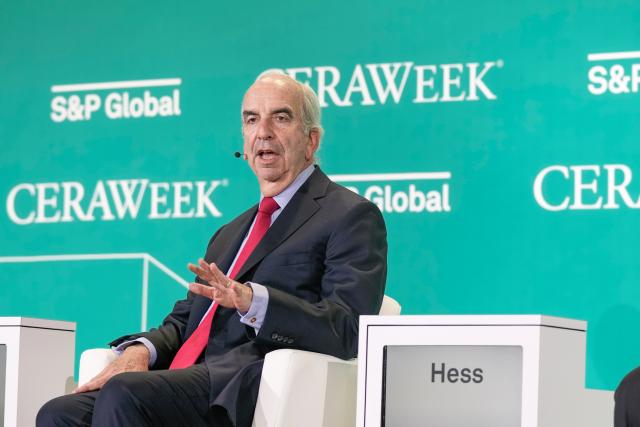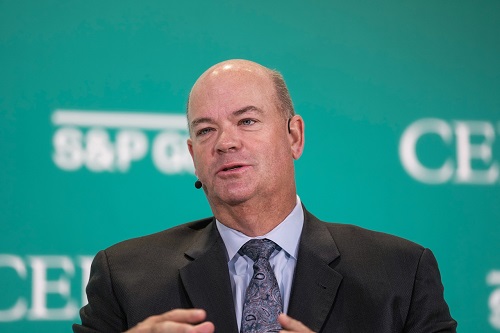
During an oil and gas panel at CERAWeek by S&P Global, Hess Corp. CEO John Hess said investments in oil and gas and clean energy have not kept up with demand. (Source: CERAWeek)
After volatility in crude oil prices in 2022, Hess Corp. CEO John Hess expects the global oil market to move tighter later this year.
ConocoPhillips Chairman and CEO Ryan Lance sees a longer-term problem: the U.S. will likely have to cope with flattening production in Permian Basin later this decade.
Both CEOs shared the stage on March 7 during an oil and gas panel discussion at the CERAWeek by S&P Global conference.
Hess sees signs that 2022 was a prelude to continued market volatility this year.
“I think you’re going to make a tight market tighter,” Hess said. “I think [2022] was a warning, but I don’t know that we’re any more prepared now.”
WTI crude prices reached levels over $120 per barrel last summer but had erased most of their gains by December 2022, when prices bottomed out around $71/bbl.
Rising interest rates and COVID-19 lockdowns in China can be blamed for pushing down demand, Hess said.

"I think it’s one of the issues the U.S. is going to grapple with,” Lance said on the panel. “[The Permian] probably does start to plateau later this decade.” Ryan Lance, ConocoPhillips
Global gas markets faced severe disruptions after Russia’s invasion of Ukraine, but barrels of Russian crude continued to find their way to market despite international financial sanctions. Although Russia cut crude production, Russian crude exports have outpaced U.S. expectations, according to Energy Information Administration (EIA) data published on March 7.
But several factors make Hess bullish on oil through the rest of 2023, including the reopening of the Chinese economy, increasing global travel and U.S. crude production growing at a slower rate, by about 500,000 bbl/d this year.
Hess maintains that there’s been an insufficient level of investment in oil and gas, as well as clean energy resources, to keep up with growing global demand.
“There actually is a structural supply deficit when it comes to energy supply, both for new energy and for oil and gas,” Hess said. “And the world needs to wake up to this.”
The EIA anticipates WTI spot prices to average around $78/bbl through the first half of 2023 before falling to $75.35 in the fourth quarter.
RELATED
Hess Corp. Reports Fangtooth SE-1 Find, Sets 2023 Capex Budget at $3.7 Billion
Permian’s plateau on the horizon?
Of the roughly 500,000 bbl/d U.S. production increase this year, the vast majority is expected to come from the Permian Basin of West Texas and New Mexico.
While the Permian has been a prolific resource for oil and gas operators for more than a decade, production in the region is beginning to show signs of plateauing, Lance said.
“I think it’s one of the issues the U.S. is going to grapple with,” Lance said on the panel. “[The Permian] probably does start to plateau later this decade.”
Supply chain constraints, labor shortages and rampant inflation continue to present challenges to companies in the Permian, Lance said.
RELATED
Rystad Energy Expects to See Exponential Growth
Recommended Reading
Tethys Oil Releases March Production Results
2024-04-17 - Tethys Oil said the official selling price of its Oman Export Blend oil was $78.75/bbl.
Exxon Mobil Guyana Awards Two Contracts for its Whiptail Project
2024-04-16 - Exxon Mobil Guyana awarded Strohm and TechnipFMC with contracts for its Whiptail Project located offshore in Guyana’s Stabroek Block.
Deepwater Roundup 2024: Offshore Europe, Middle East
2024-04-16 - Part three of Hart Energy’s 2024 Deepwater Roundup takes a look at Europe and the Middle East. Aphrodite, Cyprus’ first offshore project looks to come online in 2027 and Phase 2 of TPAO-operated Sakarya Field looks to come onstream the following year.
E&P Highlights: April 15, 2024
2024-04-15 - Here’s a roundup of the latest E&P headlines, including an ultra-deepwater discovery and new contract awards.




